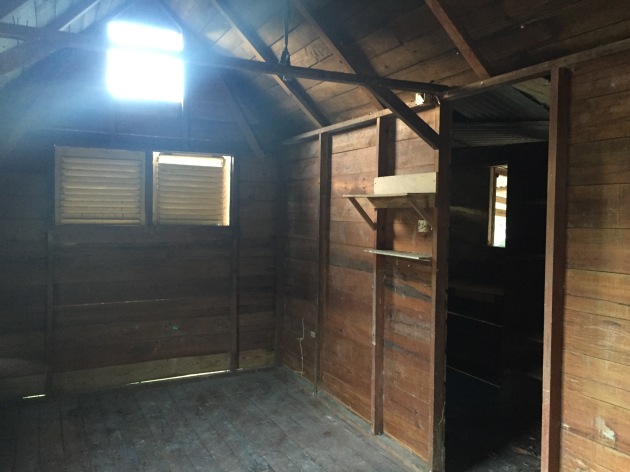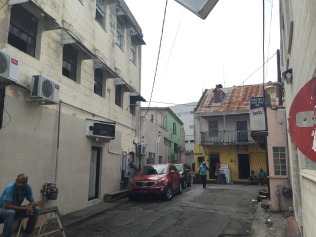I began today by catching up. Wireless is ok, but not great, so I was pretty glad to find that the café at the GW House has a strong connection. The house has become a sort of base of operations so finding out that the café’s digital dynamism made things even better. I talked more with Martin Miller and met Mikala Hope-Franklyn who also is part of the GW House team.
These folks are such great and enthusiastic young museum professionals—wonderful to talk with them. Likewise, meeting with GW Papers team as we sort of half planned and then chatting with Karl Watson the local dean of things Bajan and Historical was great.
I spent the rest of the day heading north. Nominally, St. Nicholas Abbey was my destination, but as is often the case the trip and getting lost a few times was built into the plan. There is a highway that heads north though to Americans it is really just a four lane road punctuated by roundabouts. I switched on local new radio and charged north. In several places the sea view just opens up and again you get that feeling of being on an island. I keep trying to remind myself that this place is small and remote even, but it seems pretty all encompassing when here. Only the sea—flat and empty in all directions highlights isolation, and the place is so packed and bustling that without the sea in sight, you forget.
I got to the home to too late for a tour so I just took some pictures and sheltered from a short rain storm. This is the oldest of the seventeenth-century homes and is managed as a museum and events all. Lots of latter additions behind it and I could hear meetings going on. There also is active sugar cultivation on site and the barns were busy.
Once I was done, I knew I wanted to head down the eastern side of the island having come up the west. What I did not know was that the road was going to slam me into what is honestly one of the best views in the western hemisphere. It comes up on suddenly. You drive along going up a hill, minding your own business, listening to the BBC talking about Syrian peace talks, then in an instant,
you crest a hill and the whole eastern shore of the island is hey presto spread out before you from atop a high hill. There is a little pull over and I jumped out of the car. Clearly people picnic here judging from the hundreds of chopped coconuts and the stacked push carts of the now off duty vendors. Either the rain or the lateness of the day though left me with the place to myself, so I climbed up a very steep trail to see if the view was better a bit higher and off the road. It actually wasn’t, but something about getting off the road and into the fields made me think about all the Africans, Irishmen, Indians, and others for whom this place was a living hell, a purgatory, a prison with no hope of escape. Seeing the hills, the shore, and sea in that light brings home the loneliness, sorrow, and misery that is so much a part of the history of this place and others like it. Earlier on my drive, I had seen the statue at Emancipation Circle—a bronze of a man standing up in a pose much like the old Massachusetts’s seal, but with broken chains hanging from his wrist manacles.

Emancipation Circle
It is a good memorial—and seeing from this perch just how small and inescapable was this Barbados drove home what had been at stake. The emancipation statue is a remarkable thing—even though drivers whiz around it all day long presumably without remarking. We in the US are now in the midst of our own debates about statues and for the life of me I could not think of a single monument like this one. I assume that is a failing of mine, but nevertheless, I think American monument makers have made it easy for me to not recall one. We have though used considerable bronze to commemorate some aspects of, and characters from slavery’s story in almost all southern cities—but none, or at least very few, have hands with the chains broken. Curious that. I am not for the removal of Confederate monuments outright, but then again, I am a preserver and not a remover by nature and by professional inclination, so my impulse to leave them in place needs to be seen (and appropriately devalued) in light of that fact. But recontextualizing would certainly be a very good thing. What does a metal Robert E. Lee mounted a-top a metal Traveler look like if they was surrounded by castings of the emancipated? What if the base of the statue was fitted with a giant manacle or one of those pronged collars designed to make it impossible for the poor wearer to move about or lie down? It is a discussion long overdue.
The sun was setting as I drove home. The cyclist are out at the starts and ends of the days and I was so full of jealousy when I had to pass a few pace lines and group rides. These are the serious miles riders with good bikes, helmets, lycra, and lights—my people! The roads are very rough and the guy at the cycle shop said that it was an increasing problem for riders. The government here is suffering financial problems. Barbados’s economy is almost entirely tourism-based, and as the word economy slowed down, people stopped coming here. One manifestation of the problem is that there is not money to repair and maintain roads–and you can really see it everywhere you go.

Photoshelter.com had a better photo of the Oistins market stalls than I could take, so here it is. This is a big scene in the evenings. Lots of people chatting and eating.
At the end of the day I stopped in Oistins to sit in the market and let the night come over. I reread GW’s Barbados diary again to see what parts I might see anew in light of today’s visits. He saw the form of plantation slavery here and he had to have known that was different in some respects from what he knew at home in Virginia. He never commented on it though. I saw reminders and memories of that plantation slavery, and they were quite different than what we have back at home. When it comes to commemorating the memory, we have a lot to learn.
 Clarke was a member of the Governor’s Council and a prominent merchant planter on the island. He also was the brother of Deborah Clarke, William Fairfax’s second wife and mistress of Belvoir during Washington’s visits there. This connection made Clarke the Washington brothers’ main contacts on the island. On arriving they were welcomed by Major Clarke–Toner’s transcription of the GW Diary identifies him as Somers Clarke, but there is good reason to think that it was actually Gedney Clarke. As a side note here, we can all be thankful that the
Clarke was a member of the Governor’s Council and a prominent merchant planter on the island. He also was the brother of Deborah Clarke, William Fairfax’s second wife and mistress of Belvoir during Washington’s visits there. This connection made Clarke the Washington brothers’ main contacts on the island. On arriving they were welcomed by Major Clarke–Toner’s transcription of the GW Diary identifies him as Somers Clarke, but there is good reason to think that it was actually Gedney Clarke. As a side note here, we can all be thankful that the 








 I pulled over and hopped out. The house was made of very small light wood—no heavy framing and all wooden strips inside (no sheetrock for example). This one had a small shed addition which contained a toilet and a sink, but no evidence of plumbing. Here was the Tiny House par-excellence and I tried to imagine what it would be like to live in one—alone or with a family, this is a very small space. Obviously, much of one’s life would be lived outdoors or elsewhere. But having loved many an AT shelter, it was easy to imagine being quite happy in one—especially with the Atlantic stretching blue to the east within sight. Of course a good wind storm would knock my little domicile around like a cardboard box. But Barbados is spared most storms as a result of being outside the actual Caribbean basin, perhaps accounting for why these houses abound.
I pulled over and hopped out. The house was made of very small light wood—no heavy framing and all wooden strips inside (no sheetrock for example). This one had a small shed addition which contained a toilet and a sink, but no evidence of plumbing. Here was the Tiny House par-excellence and I tried to imagine what it would be like to live in one—alone or with a family, this is a very small space. Obviously, much of one’s life would be lived outdoors or elsewhere. But having loved many an AT shelter, it was easy to imagine being quite happy in one—especially with the Atlantic stretching blue to the east within sight. Of course a good wind storm would knock my little domicile around like a cardboard box. But Barbados is spared most storms as a result of being outside the actual Caribbean basin, perhaps accounting for why these houses abound.











 The seventeenth-century Jews of Barbados lived in a world so different from ours and from the reality of Barbados today just outside the wall. But at the same time, the names and fact of a shul again close the time and make the alien familiar. Visitors’ stones are on many of the graves: a pleasant bond over time and space.
The seventeenth-century Jews of Barbados lived in a world so different from ours and from the reality of Barbados today just outside the wall. But at the same time, the names and fact of a shul again close the time and make the alien familiar. Visitors’ stones are on many of the graves: a pleasant bond over time and space.





Recent Comments